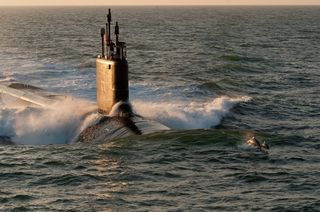On 17 April, Deputy Prime Minister and Minister for Defence Richard Marles released Australia's 2024 National Defence Strategy in response to the Defence Strategic Review.
Today, experts from the United States Studies Centre (USSC) at the University of Sydney provide their responses to the new strategy and what it signifies for the future of alliances and partnerships across the region.
Dr Michael J. Green, Chief Executive Officer
Australia’s new defence plan sets the right tone on the China challenge and the right direction for the ADF overall, but questions about adequacy of budget will linger as they do for most democracies right now.
Prof. Peter Dean, Director of Foreign Policy and Defence
My first cut take on the National Defence Strategy is that the spirit, intent and direction of the Defence Strategic Review (DSR) is maintained and government priorities are focused in the right areas. It is a very welcome injection of new funds for uplift. By 2034 Australia's defence budget will double.
On first look it is at least $1B per year over and above already announced investments. The focus on the US alliance and other partnerships is excellent, especially with Japan.
Overall it is a very good document, on track from the DSR and a natural evolution.
Tom Corben, Foreign Policy and Defence Research Fellow
The framing of the inaugural 2024 National Defence Strategy is notable for its emphasis on ensuring that Australia is well-positioned to contribute to a favourable strategic balance in an increasingly multipolar Indo-Pacific where no one power is, or should be, dominant. This is not simply a clear-eyed recognition that US military power in Asia is in relative decline: it's an assessment that a favourable balance of power and a regional order beneficial to Australian interests ultimately depends on building out a strategy of collective deterrence with the United States, Japan, India and others – a strategy to which Australia has indispensable contributions to make now and in future years.
Importantly, that strategy will depend on a military capable of undertaking operations and activities out in the wider region, not simply in Australia's immediate waters and airspace. In that sense, the emphasis on reorienting the Australian Defence Force from a highly flexible to a more focussed force capable of delivering deterrence effects far from Australian shores is appropriate. Focussing on the development of power projection capabilities with "operationally and strategically relevant ranges", including platforms like submarines and a range of specific long-range precision missiles and unmanned systems, will be critical to meeting threats to Australian interests out in the region where they are most acutely manifest.
Sophie Mayo, Foreign Policy and Defence Research Associate
When it comes to technology innovation and Pillar II advanced capabilities, the NDS offers a sensible blueprint for progress. Critically, it previews greater engagement from private capital, noting the government will establish criteria, pathways and mechanisms for private equity and industry engagement on AUKUS Pillar II. If established and implemented quickly, this will help to deliver demand signals that private capital and industry desperately need in order to go all in on AUKUS Pillar II.
Alice Nason, Foreign Policy and Defence Research Associate
The National Defence Strategy provides an additional level of granularity and long-awaited resourcing to the priorities of the 2023 Defence Strategic Review. The document further embeds the AUKUS partnership in the fundamentals of Australia’s future defence. In his remarks, Marles pointed to AUKUS submarines as intrinsic to deterrence by denial. The greatest share of new money budgeted for Defence is devoted to undersea capabilities, including $53-63 billion for conventionally armed, nuclear-powered submarines and associated infrastructure over the next 10 years.
The strategy offers a welcome reflection on Australia’s capacity to make commitments outside its near region. Where the document is frank that collective security in the Indo-Pacific is synonymous with Australia’s national security, it provides an unambiguous assessment that the Indo-Pacific is where Australian resources must remain. As conflicts in Europe and the Middle East continue, the National Defence Strategy provides clearer guidepost for determining where contributions overseas lie in Australian national interests.
The National Defence Strategy takes an ambitious approach to next-generation capabilities. However, what is less clear from the document is how Australia’s near-term capability requirements will be met. Progress in Australia’s Guided Weapons and Explosive Ordnance Enterprise evident in the Strategy might provide part of an answer. In coming days, this is the question analysts will mull over.












